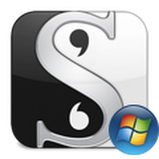On September 11, 2012, the document editor in Google Docs (now part of Google Drive) finally became useful to me for use in writing groups. The web app has long had a feature that enables users to create, reply to, and resolve comments in a Google document, much like the commenting system in Microsoft Word. But the Android app lacked these features until now.
Why You Should Use Google Docs and Drive in Your Writing Critique Group
No longer will I have to sit in front of my computer to read (not as pleasant as reading on a tablet) and comment, or read on my tablet only to return to my computer periodically to record my reactions (to the best of my memory), or switch between documents or apps on my tablet (a pain). Finally, I can open a writing-group partner’s chapter on my tablet, sit back and relax and read through it, and insert my reactions as I have them directly in the document — all without having to be anywhere near my laptop. This being Google Drive, the rest of the writing group will be able to see my comments as soon as I save them.
If you do all of your (early draft) writing in Google Drive anyway, most of what follows may not be all that useful to you. All you need to do to use Google Drive in your writing group is share your document with the other members and enable commenting. No need to email Microsoft Word documents or RTF files back and forth. No need to print out multiple copies of your story, exchange them with your group, and then receive multiple marked up copies back a week or more later. Just share a link, and everyone’s comments will appear in your single document.
Google Drive and its office suite, Google Docs, are perfect for online writing groups, but writing groups that meet in person can also find them useful.
If you prefer to use a different word processor for your writing, you can still use Google Drive in your writing group to share documents and comment on them. There will just be more steps involved in exporting and importing your files to and from Google Drive. Below I’ll lay out the steps for doing this, with a focus on the Scrivener for Windows app because it is such a fantastic writing tool and the process involved with it is a little more complex than, say, for MS Word.
Before launching into the tutorial, allow me to first plug our community forums. If you’re a liberty-loving fiction author or aspiring fiction author, you may be interested in exploring and participating in a set of forums we created just for you. In these, you can discuss the craft and business of writing, participate in writing groups, and showcase your work.
Downloading and Installing Google Drive
Google Drive is a cloud storage service and web app, but it has a corresponding desktop client as well. It works much like Dropbox. The easiest way to import your files to Google Drive is to install the desktop client. Once installed, you can simply save your files in, or export your files to, the Google Drive folder on your computer. The client will automatically upload any files placed in this folder to your account in the cloud.
To install the Google Drive desktop client on your computer, go to the download page and click on the blue “Download” button.
In the dialogue window that pops up, click the blue “Accept and Install” button.
That’s pretty much it. You may have to grant the installer permission. Follow Google’s prompts to complete setup.
You may want to create a subfolder within your Google Drive folder just for your writing group’s documents.
If you don’t want to go this route, you’ll have to import files manually from the web app’s interface; there’s a red upload button next to the red “Create” button at the top of the left sidebar.
Exporting from Scrivener to Google Drive

Exporting all or part of your manuscript from Scrivener is easy.
Start up Scrivener.
To export the entire story, first click on the parent folder in the binder, which might be titled “Manuscript.” To export part of your manuscript, click on the part, chapter, or scene folder/file in the binder that you want to export.
Next, click on File > Export > Files or press CTRL+SHIFT+X on your keyboard.
In the dialogue window that pops up, you can
- select the export destination (choose the Google Drive folder, or the writing-group subfolder you created within it),
- rename the exported file (optional; I don’t),
- and select the export file format (pick .rtf or .doc; Scrivener will convert to .rtf on import anyway, so you might as well export .rtf).
You’ll probably have no reason to check any of the four options below the export-format menu.
Click Save, and you’re done.
Other Writing Software: If you’re using a different word processor, like MS Word, you don’t need to do any exporting; just save the document you want to share in your Google Drive folder.
Converting Your File into a Google Document to Enable Commenting
Once you’ve exported your work to the Google Drive folder on your computer, it will be automatically uploaded to your Google Drive account in the cloud.
Unfortunately, you’ll have to convert the .rtf or .doc file to the Google document format before you can enable commenting or edit the document. Still, this is not a difficult or time-consuming process.
Open the Google Drive web app.
Open the file you want to convert.
Click File > Export to Google document.
That’s it.
Now you can share the document and enable commenting.
Click on the blue “Share” button in the top-right of the Google Drive document page.
In the dialogue window that pops up, you’ll find the url to your document and also be able to add members of your writing group to the list of those who can access your document.
Enter the email addresses of your writing-group members in the “Add people” box. Before clicking the green “Share & save” button, be sure to click on the “Can edit” link to the right of the box and change the setting to “Can comment.” Click the green button, and you’re done!
Using the Commenting Feature of Google Docs to Critique
The first thing you should do is set your notification settings. Click on the white “Comments” button in the top-right corner of your document page, then click on the “Notification settings” link in the resulting dropdown window. In the dialogue window that pops up, enable email notifications and make sure all of the boxes below it are checked.
Now that you’ll be informed whenever someone comments on your document, I’ll briefly go over the two ways to comment on a Google document in the web app.
- You can attach comments to specific passages of text. When you import your document back into Scrivener, these comments will be converted to inline annotations next to the text you attached them to. To create these: Highlight the text you want to comment on. Next, click Insert > Comment, or right-click on the highlighted text and click on “Comment” in the context menu, or press CTRL+ALT+M on your keyboard.
- You can add comments to the document as a whole, which is useful for general observations about the work you are critiquing. These comments will be converted to inline annotations at the bottom of the page in Scrivener. To create these: Click on that white “Comments” button and type into the text input field.
- For text specific comments, highlight the text you want and tap the talk-bubble icon in the context menu that pops up.
- For general comments, tap the talk bubble icon in the menu bar at the top-right.
After a Critique Session: Downloading Your Critiqued Document Back to Your Computer
Now you’ve got a Google document loaded up with comments from your writing group. How do you get those comments back into Scrivener, or MS Word, or whatever other word processor you are using? It’s pretty easy.
Open the Google Drive web app.
Open your document.
Click File > Download as > [the file format you want]. For Scrivener, select Rich Text Format (.rtf). If you’re a MS Word user, select the .docx format.
Save the document into your Google Drive folder, overwriting the original that you had converted the Google doc version from.
For Scrivener, your next step is to import this RTF file. For MS Word, you’re all set; happy revising!
Importing to Scrivener from Google Drive
Start up Scrivener.
Select where you want the imported file to go by clicking on the appropriate folder in the binder (e.g., a chapter might go in the Manuscript or a Part folder depending on how you have your story organized).
Click on File > Import > Files or press CTRL+SHIFT+J on your keyboard.
Navigate to your document’s location and select and open it.
Even if they have the same name, the imported document won’t overwrite the original that you had previously exported. Rather, it will be imported below the original, so you’ll have an original version without any annotations and an otherwise identical version with annotations. You might want to trash the original or move it to another folder outside of the manuscript (so it won’t be included in a compile) to serve as a backup.
Now you can go through the reactions from your writing group one annotation at a time, deleting as you address them. Happy revising!
And do check out our community forums.















